The following is a synopsis of a talk given by Bernard Walsh on 17th April, 2016 on the life of the ordinary person in Athboy one hundred years ago in 1916.
The year of 1916 was a momentous year in Irish history. The events of that year, popular with some and very unpopular with others spawned a new era in Ireland. Easter Week 1916 was the conception of the Irish Republic, our Republic, our Country, the Ireland that we all know and love today, 100 years later.
But here in Athboy, we had very little direct involvement in the events of Easter Week. It is known that 3 local men travelled to Ashbourne to help out the volunteers there. But by the time they arrived there the battle was over, so they returned home. But other than that there was no direct connection between Athboy and the Easter Rising unlike the events which followed a few years later when several local men played very prominent parts in the War of Independence. But that is a story for another day.
So what went on in Athboy in 1916. The answer is simple: ordinary life went on. But what was ordinary life? Who lived here? What did people do and where did they work, shop etc. What was their recreation? That’s what we are now going to explore, mostly with the help of the newspapers of the time, some old photos of the time and a story or two thrown in here and there.
The Parish Priest of Athboy in 1916 was Father Matthew O’Farrell (1909-1934). During his term as Pastor he was responsible for a vast number of improvements in the parish, including the addition of a new sacristy at St James Church, the beautiful mosaic marble work around the main altar and side chapels, the addition of the new altar rails and the building of the Chapel of St Joseph. Father O’Farrell is credited with making many of these changes out of his own personal resources. In Clerical changes in Meath Diocese in October 1916, Fr. Peter Kelly, CC Athboy was moved to be CC in Kildalkey, while Fr. Denis Smyth, CC Kildalkey, became new CC in Athboy.
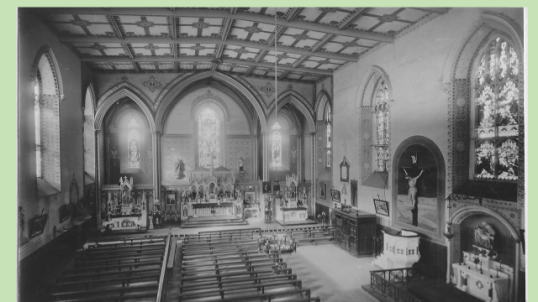
The Church of Ireland Rector in Athboy in 1916 was Rev. Henry Edward Whyte. Ordained in Belfast in 1893 he was first appointed Curate of Shankill. After further short postings to Sheffield, Belfast and Knocknamuckley, Co. Down he was appointed Rector in Athboy in 1898, a post he held for 40 years until his retirement in 1938. He died at his home, 1 Waterloo Gardens, Belfast in 1939. While ministering in Athboy he oversaw the extensive repair and redecoration of St. James Church of Ireland in 1906. In his Will he left bequests, among others, to Miss G. P. Cox, former teacher in Athboy school (£100); his former servant Annie Dunne (£50); to his former servant Bridget Maye (£25); and £100 to the Church of Ireland Parish of Athboy for the upkeep of the cemetery. Both Rev. Whyte and his wife, who predeceased him in 1937, are buried in St James Church of Ireland Churchyard, Athboy.

In 1916, the only bank in Athboy was a branch of the Ulster Bank. Located in Lower Bridge Street in what is now the present day Garda Station, the Ulster Bank moved in 1922 to a new purpose built premises in Main Street, a position it occupied until its closure in 2015. The Munster and Leinster Bank open a sub-branch in Athboy in 1921. Mr. Charles Young Pratt was the Manager of the Ulster Bank in 1916, and for many years afterwards until his retirement in the early 1940s. Charles Pratt was married to Stella McVeagh, sister of Mr. G. B. McVeagh of Drewstown and he died at his home, Gleniveagh, Kells Road, Athboy in 1945 (later the residence of Dr. Gilsenan).

A Horse and Pony Race Meeting was held in Athboy on 11th Ocotber. Eight races in all were held with entrance to the field set at 6d. The Hon. Secretaries were M. J. Mangan and M. Newman
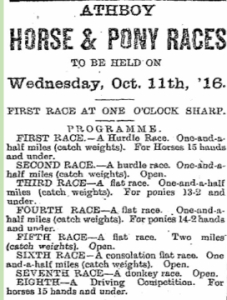
Meath Chronicle, October 28th, 1916:
Sir,
The report of the Athboy Races in your issue of 21st inst. Is a tissue of falsehood from start to finish. Firstly, you state that the field was lent, which is entirely untrue. Secondly, you state that the racing was uninteresting and each race won in hollow style. This statement is also untrue, as everyone seemed well pleased and thoroughly enjoyed themselves. We intend holding another race meeting next year and need the support of the public. Your false report is poor encouragement both to the committee who run the meeting and the public who support it. In fairness to the committee and the public at large we hope that you give this letter the same prominence as you gave the report, as probably you will be surprised to hear that the races were run from every point of view very successfully. Yours faithfully, The Athboy Race Committee.
A Coursing Meeting was held at Rathcarne on Thursday 17th February. The Hill of Ward Stake (£10. 10s to the winner), The Ballyboy Stake (£6 to the winner) and The Rathcarne Stake (£10 to the winner) were the competitions held
Fox hunting was a very popular past time for the rich and landed gentry of the time. At the Athboy Meet in November 1916, the Meath Hunt raised a fox at Caucestown, Athboy and gave chase through Addinstown, Crowenstown, Ballinlough and finished at Killua where the fox went to ground.
There was a flourishing GAA club in Athboy at this time. Both hurling and football were played. Meath were playing Westmeath in Croke Park in the Leinster Junior Hurling Championship in November 1916. A special train was arranged from Athboy and it was expected to be well filled.
From away back in the late 1800s Athboy had a flourishing Cricket club. Local derby matches were often organised, for example, Drewstown House against Clifton Lodge etc. It is the stuff of legend that the local station master, George Bowles, once delayed the departure of the evening train to Dublin so that the visiting team could finish their innings.
Meath Chronicle January 29th, 1916:
Man Found Dead Near Athboy: On yesterday (Friday) morning a labourer named Smith, aged 30, who lived near Hill of Ward, was found dead on the roadside near Athboy. There were no marks of violence on the body and death is believed to be due to natural causes. Deceased was in Athboy on business on the previous night and left for home apparently all right. The Coroner has been notified.
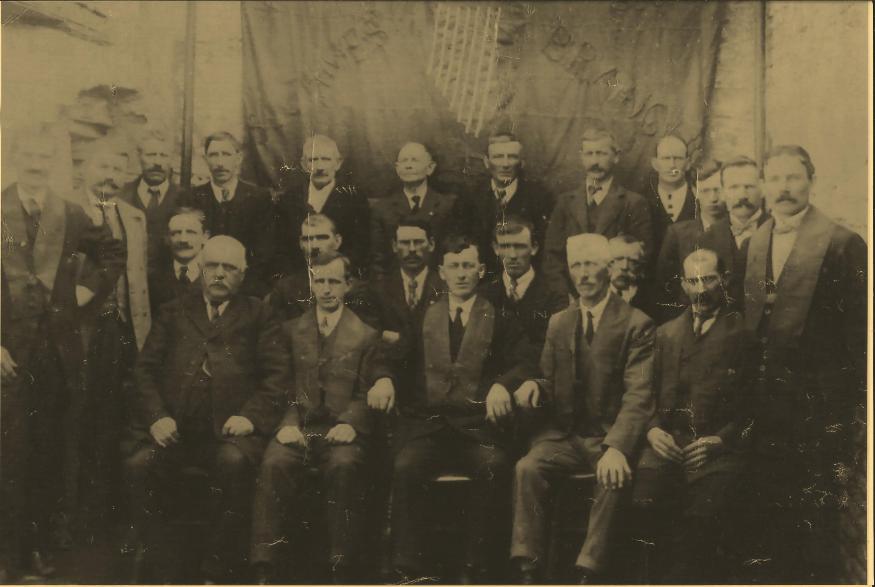
Middle row seated ; unknown; unknown; unknown; Patrick Maye, Castletown, (Mason); Thomas Brown, Main Street, Harness maker: Front row: Garry, Connaught Street; unknown; unknown; James O’Brien, Connaught Street;
Meath Chronicle, 5th February 1916:
Ancient Order of Hibernians. Athboy Division. At the weekly meeting of the above Division, held on Sunday last, a vote of condolence was passed to Mrs. Mary Smith, Mitchelstown, Athboy, and to her family, on the lamented death of Michael Smith, a member of the Division. The President, speaking on the matter, said they all very much regretted the sad occurrence, which resulted in the tragically sudden and untimely departure from among them of one of their youngest and brightest members. It was a particularly pathetic event and they were all unanimous in extending to Mrs. Smith and her bereaved family their heartfelt sympathy.
Joseph Lowry & Sons, Auctioneers, Kells, advertised the upcoming sale of Licensed Premises at the corner of Main Street and Connaught Street, on the instructions of Mr. James Fox (“who is changing his residence”). The sale was to take place on the premises on 24th February 1916.
In October, Peter O’Rourke, Main Street, Athboy, Merchant, applied to the Licensing Quarter Sessions in Trim for a permit to sell by retail, beer, cider and spirits, at his premises in Main Street, Athboy, heretofore licence for such sale was held in the name of James Fox.
In July 1916, The Freeman’s Journal reported that Mr. William Waldron of Ballyfallon, Athboy, sued Tedcastle McCormack and Co. Ltd for £2000 damages for personal injuries alleged to have been caused by the negligence of the defendants. The evidence was to the effect that on the night of 19th January, William Waldron went aboard the SS Blackrock, owned by the defendant company, at her berthage on the south side of the Liffey with his 4 children who were returning to school in England. While on board the steamer he stumbled over some obstacle and, a portion of the side deck being left open and unguarded, he fell into the water. He was rescued but his health was stated to be affected. The Jury found for Waldron and assessed damages at £400.
Tenders were sought in April by the Board of Delvin Union Workhouse for the carriage of 50 tons of coal from Athboy railway station to Delvin, the carrier to be liable for any shortfall in weights!
Fagan’s Druggist, Athboy. offered for sale specialities including Murray’s Famous Blood Murrain or Red Water Cure in 2s packets and Anti-Snore for Timber Tongue and Hoose Mixture in 1s 6d bottles. If you had an ache or a pain you could get Kumnas Magnetium Antiseptic Liniment from the local agent, Mr Byrne of Athboy. Large bottles cost 1s.1½ d. Mr. Byrne, Druggist, Athboy, also sold Whyte’s Kiola Pomade, the most active Nit killer known. Available in large tins at 4½ d each.
Thos. Fagan & Co Ltd. were agents in Athboy for the Cunard Line. Tickets could be purchased for sailings to New York and Canada. Cabins were £10 while third class fare was £6.10s
The was keen demand for cattle at the Athboy Fair on the first Saturday in March 1916. Three-year-old stores fetched from £19 to £23 each. Two-year-olds fetched from £10 to £18. 10s each and one and a half-year-olds £17. 10s each. Yearlings made £11. 10s and fat sheep from £4. 10s to £10 each.
At Trim Petty Session in November, William Sherlock, Ward, Athboy, was fined 6s for riding an unlighted bicycle. Frank Bennett, Mooneystown, who appeared, was fined 2s.6d for a similar offence.
The October sitting of Athboy Petty Sessions was held before Mr. G. B. McVeagh. Three local men were charged by Constable Gormley with using a vehicle without a light and were fined 1s with costs. The cases against 3 other men were adjourned. On the positive side just one case of drunkenness was dealt with.
In November, the Meath County Surveyor reported that there would be a serious shortage of material for road purposes in the Athboy area owing to the scarcity of men to prepare such material. The steamrolling of Athboy street was completed but it was doubtful if the surface would have a long life owing to the heavy traffic in the shape of timber carting. If money could be afforded a bottoming of rough stones before rolling would have been better.
Meath Chronicle 7th October 1916:
MISSION IN ATHBOY – A successful fortnight’s mission concluded in Athboy last Sunday evening when the spacious Church was filled with a devout congregation. The ceremonies consisted of a most eloquent sermon by one of the three Redemptorist Fathers, Benediction, renewal of Baptismal vows and Papal Blessing.
On 21st July 1916, The Most Rev. Dr. Gaughran, Bishop of Meath, visited Athboy and confirmed 90 children.
Meath Chronicle 28th October 1916:
ATTEMPTED SUICIDE IN ATHBOY – Quite a sensation was caused in Athboy on last Friday evening when it was reported that a resident of the town had made a determined, but, happily, not a completely successful attempt to commit suicide. The unfortunate victim is an unmarried man named Christopher Clery, who was for a long time employed as a bell-ringer in the local Catholic Church. He resided at Chapel Street on the outskirts of the town. With him lived the orphan girls of his sister and brother in law, both deceased. Since the death of a niece, to whom he was devotedly attached, his manner became moody and sullen, but he discharged the duties of his position regularly and on Friday morning tolled the bell for early Mass. At about 3 o’clock he sent 2 of his nieces on short errands and retired to his room. While lying on the bed he made a severe gash to his throat with a razor. When his niece returned, assistance was quickly procured and Dr. Greene did everything possible to alleviate the injured man’s condition. He was taken to Trim Workhouse Hospital and from there was committed to Mullingar Asylum. General sympathy was felt for Clery who was an industrious and inoffensive man, as well as for his nieces whose welfare he sedulously looked after.
Prequel to this story: James Clery, a porter, was killed in 1900 at Athboy railway station by being crushed between two carriages which were being shunted. His wife had died just a short time previously. They left five orphan children which were being reared by Christopher Clery.
Irish Times 17th March 1916:
In the classified ads under the section “Chauffeurs Disengaged” – Mrs Mordecai Jones, Clifton, Athboy, wishes to recommend her chauffeur: thoroughly reliable in every way: strict TT.
It was announced that the marriage arranged between Thomas William Noel Quin J.P., son of the late Thomas Albert Quin and Mrs Quin, Bellevue Place, Clonmel, and Gwenllian, widow of the late Mordecai Jones of Clifton Lodge, Athboy, “will take place very quietly in June.”
Irish Times 9th November:
For Sale; Full sized side car; with dog box; perfect condition; apply N. Quin, Clifton Lodge, Athboy.
Irish Times 8th November 1916:
Wanted, boy under military age to look after pony and wash motor, and clean boots etc. and make himself generally useful in house. Willing to work and learn; State age and wages expected, with board and lodgings. Protestant preferred. Apply N. Quinn, Clifton Lodge, Athboy.
(Note: After the death of Mordecai Jones and the murder of his Japanese manservant in 1913, Gwenllian, his widow, married Noel Quin. They emigrated to Washington State, USA, where they lived out the rest of their lives).
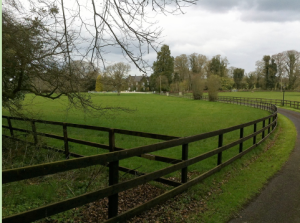
At the Galway Festival Race Meeting in August 1916 the winner of the Galway Plate, a horse called Never Fear, was trained at the Rathvale, Athboy stables of Mr R. H. Walker. On the following day, Reggie Walker turned out the winner of the Galway Hurdle, a horse called Elgon. On 14th September, Mr. Reggie Walker of Rathvale, Athboy trainer two winners at a race meeting held at Kells. Elgon won the Loyd Plate for owner Mr F. Barbour of Clonbarron, Athboy, while Kentstown won the Assocker Plate for Mr. W. Battersby. Other races contested were The Hill Plate, The Kells Plate, The Round Tower Plate and The Headford Plate.
Reggie Walker was one of the most successful trainers in Ireland at this time and for many years afterwards. As a young amateur rider, he won the Irish Grand National four times, the last time being in 1915. He also rode several times in the Aintree Grand National and his best result there was a second on a horse called Royal Danielli, owned trained and ridden by himself. Incidentally, Reggie Walker holds a unique record in Irish racing History. In one race meeting in Sligo, he trained the winners of five of the six races. All five were ridden by the then champion jump jockey, Clyde Aylin. This is a record that to the best of my knowledge has never been equalled.
Irish Independent 17th June 1916:
Tailors wanted immediately. Come to Smith’s Merchant Tailors, Athboy, Co Meath.
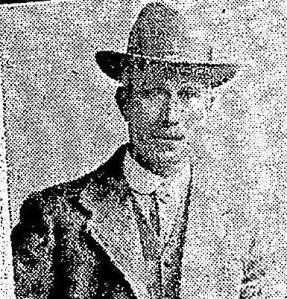
The Dispensary Doctor in Athboy in 1916 was Dr. Grene. Residing at Ivy House, Upper Bridge St, Dr. Grene held this position for a total of 37 years until his retirement in 1922. Applications for the Athboy vacancy were then invited by advertisement, the salary to be £250, rising by £5 annually to £300, plus £50 for travelling. He was succeeded as Athboy M.O. by Dr. T. J. Lynch who also purchased Ivy House at public auction for £1050. Dr Grene was also a Justice of the Peace and served for many years on the bench of Athboy Petty Sessions Court. He retired to live in London where he died in a South Kensington Nursing Home in 1929. His wife died in 1935. They had 2 sons, one of whom survived just a few hours after birth in 1888. Their second son, Cecil, became a DOctoberor and was in General Practice in Brighton.
(Note: De Grene is extensively and incorrectly referred to as Dr. GREENE, in medical, legal and newspaper articles. His correct name was Dr. GRENE.)
There were a total of 14 enrolments in St James Boys Infant School, Athboy, during 1916. The corresponding number for St James Girls Infant School was 10 enrolments. In Fraine National School 3 boys and 2 girls commenced school during 1916.
A Raleigh bicycle could be bought from E. Smyth’s shop in Athboy. Prices from £7. 10s to £16. 10s.
There were two auctioneering firms located in Athboy in 1916. T.E Potterton had an Athboy Office, operating from his home at Rathcormack, Athboy, from the late 1880s. Messrs McCann and Byrne, who also had an extensive hardware business, took out an auctioneering licence in July 1911.
Both firms dealt extensively with property sales and lettings while McCann and Byrne, in addition to their normal business, held an auction of cattle, sheep, pigs and horses on the first Saturday of each month, coinciding with Athboy fair day.
The Meath Chronicle in November 1916 reported a case where Athboy Merchant, Martin J Mangan sued M.G. R Co Ltd for breach of contract in the delivery of goods. Mangan found that in a consignment of shoes being delivered to him from Birr Bros., Bristol, cases had been tampered with and 7 pairs of shoes were missing. The Rail Company’s case was that they took delivery of the consignment at Navan Station from the G.N.R.C with the seals already broken and the cases re-coopered. The case was dismissed.
On the same day, Martin J Mangan sued the same M. G. R Co Ltd for loss of goods consigned by him (Mangan) to London. The parcel of woollens was consigned from Athboy Railway Station on Easter Monday 1916 at about 3 o’clock at a cost of 1s 4d. The goods were looted from Broadstone Station in Dublin on the following day, at the height of the Easter Week Rising. The Judge adjourned the case so that both parties might come to a mutual agreement.
Meath Chronicle 15th April, 1916:
Six Day Gaelic Entertainment In Athboy – The Gaelic Classes of the Fo Coisde are preparing for the people of Athboy a treat much out of the common – nothing less than a six-day entertainment. Commencing on Easter Monday, it will run every night, except Saturday up to the following Sunday night. The Gaelic Classes have got up plays and will produce them in turn during the week. Each night, then, there will be a different play with a distinct caste, and as there is bound to be a rivalry between the different dramatic classes, the players are likely to give of their best. Some first rate singers, reciters and dancers will assist each night.
In April, The County Surveyor sought tenders to repair 522 perches of the Athboy to Navan Road, from Clarke’s crossroads to Tullaghanstown. The job required was to supply and steam roll 400 cubic yards of broken stone at a price not to exceed £120.
On Thursday 13th April, a four-year-old colt, owned by Mrs Dyas of Athboy, (Note: Mrs Rosa Hone Dyas, widow of Nathaniel Hone Dyas of Athboy Lodge) frightened by motor cars in Grafton Street, Dublin, dashed up the thoroughfare into Anne Street and thence into Duke Street, colliding with carriages and knocking down several people, including Frederick Richards, a shop assistant, and Wm Lynam, a porter, neither of whom were seriously hurt. The animal was got under control in Dawson Street.
At Athboy Petty Session on 12th April a tramp named Patrick Reilly, against whom there were previous convictions, was sent to jail for three months for having stolen a pair of boots from the lodging house of Mrs Hughes, Athboy.
A constant trespasser, named James Mallen, who was prosecuted at Athboy Petty Sessions for allowing his pony and cow to wander on the public road, put in an ingenious plea. These particular animals, he said, were never before found on the public road, therefore he should be let off under the First Offenders Act. A fine of 1s was imposed.
Irish Independent, 12th August 1916:
Situations Vacant – Stage: Wanted Artistes: Young ; Refined: Good turns; Send photos, particulars. Shaw, Athboy.
In May 1916, a clearance auction was held in Gillstown of the farm goods of the late Harry M Dyas. Included in the extensive auction was hay in lots or by the ton, 2 farm horses, 1 pony, 1 donkey, implements, oat crushers, mowing machines, tumbling rakes, winnowing machines, anvil, carts, pony carts, drays, grindstones, ladders, pitch folks etc. etc. etc.
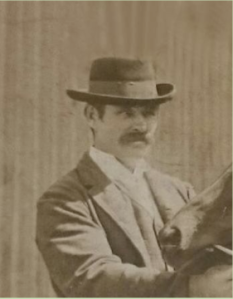
When Harry Dyas died in 1915 his entire estate was left to his wife Hilda and infant daughter, Laura Dorothea. The administration papers of his estate show that between his farms at Boltown, Gillstown, Moyagher and Balruntagh, Staholmog, Saint John’s Rath and Legagh (3 adjoining farms between Kells and Ardee) and Thomastown near Kells, that Harry held in total 2875 acres of land.
A large portion of this land was sold off at an auction arranged for October 1916, at the Gresham Hotel in Dublin Perhaps all of the Gresham Hotel in O’Connell Street, Dublin, was not destroyed on Easter weekend!
In March 1916, Trim Rural District Council sought tenders for the repair, for a period of 1 year, of public water pumps in Athboy. Full particulars could be obtained from the Clerk at Trim Workhouse.
In a further discussion at Trim Rural District Council, it was revealed that there were 13 pumps in Enfield, 6 in Summerhill, 12 in Trim and 36 pumps in Athboy district. Council member Mr. Shannon remarked : “Athboy is pretty well done for then”, to which another Council member, Mr. Maguire, replied to much laughter that “There is no dryness there!”
In December, the County Engineer reported that there were complaints about the public water pump at the Green, Athboy. The stick was decayed outside and occasionally some decayed timber comes up. Dr. Grene reported that “some people told me that there were white worms occasionally”. He thought that a sample might be submitted for analysis, but as far as he could see the water was clear and tasteless, and some users said that the water was all right. It was decided to take no action.
From 29th May, 1916 the scheduled passenger train service from Dublin to Athboy resumed, departing Broadstone Station at 9.25 am and 6.10 pm. The night mail train service also resumed.
A widowed mother of nine children, Mary Coleman of Bridge Street, Athboy, was the District Nurse at this time. Mary was born in Crookedwood, Westmeath and moved to Dublin where she married Joseph Coleman from the same parish. Joseph died in 1895 and Mary then trained as a midwife before moving to Athboy. She took up the job of Area District Nurse and Midwife, a position she held for 37 years until her retirement in 1933. Mary lost one son, Thomas, who was killed in action in France in 1914 at the start of WW1. She died in June 1946.
Probably the biggest employer in the Athboy area in 1916 was Kirkpatrick Sawmills in Bridge Street. The Athboy sawmill was one of four mills run by Mr William Kirkpatrick. The others were located in Drogheda, Kilcock, and Kilworth, Co Cork. With a sales office located in Finsbury, London, Kirkpatricks proclaimed in their advertising of the time to be “Contractors to His Majesty’s Government”. Located on the bank of the river, on the site of the present McCann and Byrne warehouse, the Athboy sawmill was driven by a 30 horsepower steam engine which kept the five saws going, all under the watchful eye of Mr. McGlennon, the site foreman. There were over a dozen men employed in the sawmill itself and over twenty more in cutting and carting the raw timber to the mill. The logs were piled up around the sawmill yard and in due course were conveyed to the saw benches on a lorry which ran over a little railway made from wood which ran through the centre of the yard (Meath Chronicle, 4th April , 1906). The mill output was sold to local builders and farmers and also “exported” to Dublin via the nearby railway station. Uncut timber was also sent to Dublin via rail, the loading and unloading of which was a heavy, laborious and very dangerous job. A special device, like a large inverted letter U, was moved along the length of the loaded carriages to ensure that no logs protruded from the side or top of the load which would catch in bridges etc. William Kirkpatrick’s Sawmill operated in Athboy from 1903 until he retired in 1933 and went to live in The Isle of Man. The sawmill was then taken over and operated for many years by Mr. Cunniffe from Athboy.
Another of Athboy’s biggest businesses in 1916 was Newman’s Mill located on Bridge Street. A mill had been in existence here since at least the late 1700s but in 1878, the business was in severe financial difficulties, under the stewardship of brothers John Valentine Cassidy and Peter Ferdinand Cassidy. The mill was sold on the order of the High Court in Dublin. It was described in The Freeman’s Journal, 2nd February, 1878, as extensive and well known with an abundant supply of water from the nearby river. The premises could be used as a Brewery or for any other manufacturing purpose. The machinery included five pairs of grinding stones, sheller, sifter etc. The mill was bought by the Newman Family in 1878 and the business thrived under the management of Thomas A Newman until his death in 1939 at the age of 82. The mill was then run by his son, Michael. With its associated Grocery and Provisions shop, Newman’s Mill was a big employer in the Athboy area, not only directly but also in indirect employment, for over 100 years. The mill was sold to Waterford Foods in 1996 with the site eventually given over to housing development in the early 2000s.
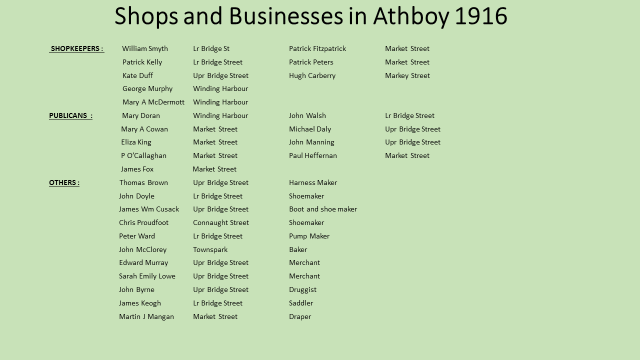
Edward Smyth of Lr Bridge Street is described as a Master Cycle and Motor Engineer whose two employees were Wm Walter Byway, a mechanic, and Wm John Piggott, an apprentice mechanic.
James, Patrick and Peter Rispin of Eighty-eight Acres were Blacksmiths. Patrick Ahearn of Lr Bridge St was an ex-RIC man and General Merchant. He was the father in law of Martin J. Managan a draper.
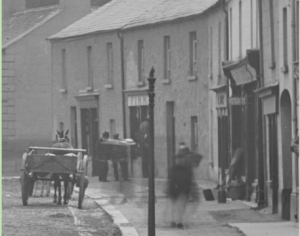
Another business which was trading in 1916 was the drapery shop of John C. Finn. The Athboy shop was in fact the second retail outlet of Finns, the other was located in Kells. Having acquired The Old School House (the present-day Boyle Sports, located between Murphy’s Furniture Store and Staunton’s Pharmacy) John C Finn set about completely renovating the premises in 1910 and from then onwards carried on a thriving drapery business for many years. After his death, the business was run by his son, Seamus (Jimmy) Finn, (who had a distinguished career in the Old IRA during the War of Independence).

Another significant employer in the Athboy area in 1916 was the Midland Railway Company. Although no records remain of how many people actually worked at Athboy Railway Station, we can safely take the 1911 Census returns as a good indication of the numbers employed there.
George Sankey Bowles, Townsparks – Station Master
Henry Blackmore, Townsparks – Train Driver
John Kavanagh, Eighty-eight Acres – Railway Guard
Michael Anderson, Winding Harbour – Signalman
Peter Ennis, Lr Bridge St – Fireman
Peter Kelly, Lr Bridge St – Milesman
Bernard Lynch, Mitchelstown – Railway Labourer
Hugh Daly, Eighty-eight Acres – Porter
Bernard Sweeney, Connaught Street-Porter
Tom Sherrock, Winding Harbour – Porter
William White, Townsparks – Porter
A big employer at this time of 1916, and very easily overlooked, would have been “The Big Houses”. The 1911 Census is the best guide here. This shows that McVeaghs in Drewstown had 7 live-in servants; Reggie Walker of Rathvale -7; Claude P Coghill 5; Parrs 4, Hopkins 1, Alleys 3, Rosa Hone Dyas 3. (total 30) Add to this the fact that each of these houses would have had other staff, both in-house and on the land (gardeners, herd, labourers, grooms and maybe a coachman or chauffeur) then it is not beyond the bounds of probability that these 7 houses just named collectively would have employed well over 100.
We will now move on to have a look at Athboy and the effects of The Great War on people here. For there can be no doubt that The Great War did have an effect on the lives of every man, woman and child in this town, and every other town on these islands and much further afield too. Athboy was missing its heart during these years, its beating heart of the youngest and fittest of its men, for only the youngest and fittest were chosen to fight in the deadliest conflict ever on this planet.
A detailed look at the Athboy men of WW1 is beyond the scope of this talk. It is truly a subject for another day and perhaps we will do that at some point in the future, but for now, we will just try and get an overall view.
So how many men from this town went to fight in WW1. In the early years of the war, a Navan man, AJ Horneck, a journalist with the Meath Chronicle, published a list of men from County Meath who enlisted in the armed forces. This is his list of men from the Athboy area who enlisted. This is not quite a complete list though because I can add at least another ten or more who are not recorded here. This would make a total of approx 55 to 60 men. And note here that this list is from the beginning of the war. Others would no doubt have enlisted as time passed.
Perhaps some enlisted as a result of the following…….
Meath Chronicle 4th March, 1916:
Recruiting Committee for Athboy – On Saturday, February 19th a recruiting committee meeting was held in Athboy to consider the best method to encourage recruiting in connection with Lord Wimborne’s scheme. Mr. McVeagh of Drewstown was elected Chairman and Mr. C.P. Coghill of Athboy as Secretary. A Letter of apology from Rev P Kelly, CC, Athboy, for non-attendance was read to the meeting.
Dear Mr McVeagh,
I do not think it will be possible for me to attend the recruiting meeting this evening, but I assure you that the objects of same have my entire sympathy. So far, Ireland has done splendidly in the matter of recruiting. She has thrown herself heart and soul into the titanic struggle and has sent thousands of her best and bravest sons into the fighting line, to hurl back the ruthless invader, and to lend a helping hand towards the complete smashing up of this blunted and deified Prussian military machine. For the past eighteen anxious months our Irish Regiments have covered themselves with glory on far foreign fields; but, alas, their ranks have been terribly thinned, and today the gallant survivors are calling on their own kith and kin at home to come forward to fill up the gaps. As we are living here in normal peace and tranquillity, far removed from these awful scenes of carnage, few of us realise that the real issue of this war, (if we view it from a purely selfish standpoint), is one of life or death for Ireland. Our brave men at the front know it well. They know that they are out to fight for their very existence, to defend out firesides and homes, our Churches and schools and institutions, and everything else we hold dear, from the desolating hand of the spoiler. Ireland is exempt from the small measure of compulsion that is being applied in Great Britain, hence, it is our duty, now more than ever, to see that the Irish regiments are maintained at full fighting strength until the cause of the Allies is brought to a triumphant issue”.
Yours faithfully,
P Kelly CC,
Athboy.
A sport was organised on Saturday, Sept 23rd in conjunction with the visit of the 5th Leinster Battalion to the town.
Meath Chronicle, 7th October 7th, 1916:
As a result of the recent visit to Trim by a detachment of the 5th Leinster’s 2 recruits, both boys of about 17, were obtained. Greater success seems to have attended the stay of the same body of soldiers in Athboy. There, it is reported, ten enlisted, the number being composed of young men from the Athboy, Ballivor and Delvin districts
Meath Chronicle 4th November:
Amongst a number of non-commissioned officers and men who had been prisoners of war in Germany and were recently repatriated, was Pte W Ward of Athboy.
In January 1916, a group of Athboy Carol Singers contributed £6. 8s 0d to the Leinster Regiment Comforts Fund. The group consisted of Misses Winnifred and Hilda Hopkins, Ethel Coghill, Olive Lowe, Phyllis Lowe, Bella Fitzgerald and Lilian Rowe.
Sgt. William Byrne-Clarke, Inniskilling Dragoons 21033, was killed in action in France. He was the elder son of Mr P J Clarke, ex RIC, and brother of Mr L J Clarke, Urlingford, Kilkenny. His widow and young son resided at Martinstown, Athboy. His Commanding Officer, writing to Mrs Byrne-Clarke says her husband died in the act of trying to save his Captain and Lieutenant. He was a great soldier and died a hero.
Irish Times June 20th, 1916:
Military Cross For Irish International Footballer:
In the list of honours for distinguished conduct in the field which was published in the London Gazette of June 3rd, appears the name of Lieutenant S. J. Parr, of the Royal Dragoons, who was awarded the Military Cross for conspicuous bravery in the fighting at Loos. Lieutenant Parr is the popular Irish International Rugby forward and is the son of Mr. B. W. Parr of Athboy, Co Meath, the well-known breeder of racers and chasers.
Also in June 1916 it was reported that Capt J E Knott of Lisclogher, Athboy, was awarded a DSO. He was a member of the Inniskillings. He was later promoted and as Lt Col J. E. Knott, CMG, DSO he relinquished his commission in 1919 on the grounds of ill health as a result of wounds received.
In November, The Irish Times announced “Capt. Victor Henry Parr is awarded the Military Cross. This is the second son of Mr. B. W. Parr, Ballyboy, Athboy, who has received the Cross; his younger brother, Lieutenant Sydney John Parr, the popular international footballer, received the award very early in the year.”
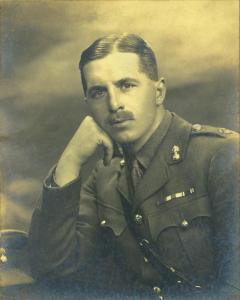
Victor’s citation says that he was awarded the MC “for conspicuous gallantry in action. He rallied men of different units in a wood during an enemy counterattack, and although wounded himself, he led them forward and beat off the attack”. The following year, 1917, Victor was further decorated by being awarded a DSO “For conspicuous gallantry and devotion to duty when in command of an advanced battalion headquarters. On his way there he mopped up three machine guns and took 50 prisoners. On the battalion being forced back, because both its flanks were exposed, he was responsible for its orderly retreat. Practically all the officers were either killed, wounded or missing, and the casualties at this time were about sixty per cent. He himself was wounded, but by his resolute action the advance of the enemy was delayed and the troops in the rear given time to take up covering positions”.
In 1916 Athboy man Frederick Maurice Watson Harvey first saw action in WW1. Having been born in the Rectory, Athboy in 1888, (his father was Church of Ireland Rector in Athboy) Fred Harvey excelled at sport in his youth. He played rugby for Wanderers Club in Dublin and represented Ireland in the Home Nations Championship in 1907. He emigrated to Canada in 1908 where he worked as a surveyor in Alberta. On May 18th 1916 he enlisted in the Canadian Mounted Rifles and later that year, as Lieutenant Harvey, he was posted to France. In 1917 he was awarded the Victoria Cross, (the highest military decoration awarded for valour “in the face of the enemy”).
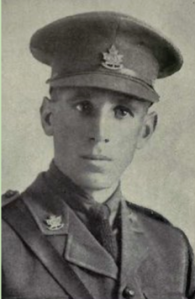
He was also awarded a Military Cross, Croix de Guerre, and in later life a CBE. After the war Harvey remained in the Canadian Army and over the following years he was promoted to the highest ranks. As Brigadier General Frederick Maurice Watson Harvey, VC, CBE, MC, Croix de Guerre, he retired in 1945. He died in Alberta in 1980, aged 91 years.
So, of the 60 or more who enlisted from this area let us now look to see how many failed to make it home:
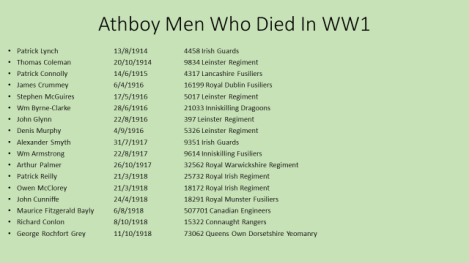
This is a list of the men from this area who were killed during WW1. Some of these names will be familiar to you. Some were Athboy men in the full sense of the word i.e. they were born and reared here and lived here. Others have less of a direct connection with the town but ALL have one thing in common the name of Athboy town appears in their military records.
Of this 17 men, 11 are buried in Military Cemeteries in Northern France, Belgium, and Gallipoli. 6 are commemorated on various War Memorials because their bodies were never recovered from the battlefields where then fell. Sadly, one of these men died from self-inflicted wounds.
It is impossible to know how many of our local men were wounded or maimed during the war. But it is possible to say that every last one of them carried the mental scars of their ordeal for the remainder of their lives.
So there we have it. Athboy is a very different place today, one hundred years later. Or is really that different? Certainly a lot has changed over the past one hundred years, but still a lot remains the same. After all, ordinary lives are still lived by ordinary people. Athboy is still our town, our community, our home.


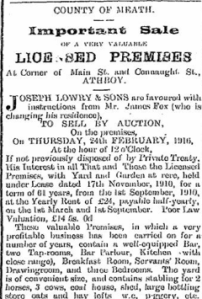

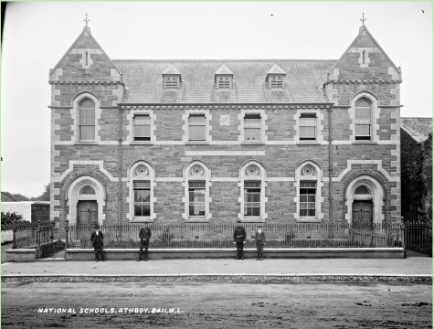
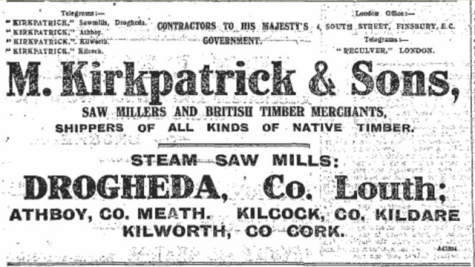

Very interesting reading. Would it be possible to get more information on Peter Ferdinand Cassidy and John Valentine Cassidy mentioned above of Athboy Mill prior to it being Newmans Mill- John Valentine was my grandmothers grandfather. Any information would be much appreciated.
LikeLike
Very interesting reading. Would it be possible to get more information on Peter Ferdinand Cassidy and John Valentine Cassidy mentioned above of Athboy Mill prior to it being Newmans Mill- John Valentine was my grandmothers grandfather. Any information would be much appreciated.
LikeLike